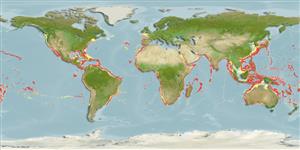>
Scombriformes (Mackerels) >
Gempylidae (Snake mackerels)
Eponymy: In Greek mythology, Prometheus stole fire from heaven to give to mankind: for which he was bound to a rock where an eagle was sent to feed upon his liver (which then grew back, to be devoured anew the next day). [...] (Ref. 128868), visit book page.
More on author: Cuvier.
Environment: milieu / climate zone / depth range / distribution range
ນິເວດວິທະຍາ
ສັດທະເລ ກ່ຽວກັບ (ຢູ່)ເທິງຊັ້ນພື້ນດິນໃນທະເລເປີດ; ປາທີ່ມີການເຄື່ອນຍ້າຍໃນສະເພາະມາະຫາສະມຸດ (Ref. 51243); ລະດັບຄວາມເລິກ 80 - 800 m (Ref. 2683), usually 300 - 400 m (Ref. 5217). Subtropical; 50°N - 36°S, 180°W - 180°E
Tropical and warm temperate waters of all oceans, but absent from eastern Pacific except at Sala y Gomez Ridge.
Length at first maturity / ຂະໜາດ / ນ້ຳໜັກ / Age
Maturity: Lm 47.4 range ? - ? cm
Max length : 100.0 cm SL ຕົວຜູ້/ບໍ່ມີເພດ; (Ref. 6181); common length : 40.0 cm SL ຕົວຜູ້/ບໍ່ມີເພດ; (Ref. 3403)
ຄີ (ໜາມ)ແຂງຢູ່ຫຼັງປາ (ທັງໝົດ) : 18 - 20; ຄີຫຼັງຂອງປາ (ຄີອ່ອນ) (ທັງໝົດ) : 17 - 20; ຄີ(ໜາມ) ແຂງຢູ່ຄີກົ້ນປາ
ກຸ່ມປາກະດູກແຂງ
ຄວາມຖີ່ຂອງກຸ່ມຖ່າຍທອດພັນ
ປາທີ່ມີການເຄື່ອນຍ້າຍຈາກທະເລໄປຫານ້ຳຈືດ ແລະນ້ຳຈືດຫາທະເລ
ປາທີ່ມີການເຄື່ອນຍ້າຍຈາກທະເລແລະໄປໄຂ່ຢູ່ນ້ຳຈືດ
ຄີກົ້ນຂອງປາ
ສັດທີ່ມີກະດູກສັນຫັຼງ
ການຖ່າຍທອດທາງກຳມະພັນຈາກພໍ່ແມ່ຫາລູກ: 2 - 3; ຄີກົ້ນຂອງປາ: 15 - 17. Body moderately elongate. Mouth with fang-like teeth. Spinescent gill rakers on the first arch with 1 - 3 cusps and many small spines; the angular raker long and triple-rooted. Body entirely scaled at over 20 - 25 cm SL. Pyloric caeca 7 or 8. Color is grayish to copper brown; fins blackish at over 40 cm SL, yellowish with black tips in smaller specimens (the first dorsal fin with a black blotch on two anteriormost membranes); the buccal and branchial cavities are black. Pelvic fin reduced to one spine that becomes entirely absent in specimens more than 40 cm SL.
Found at continental slopes, around oceanic islands and submarine rises (Ref. 6181). Meso-benthopelagic (Ref. 58302). Migrate to midwater at night (Ref. 6181). Feed on fish, cephalopods and crustaceans (Ref. 6181). Eggs and larvae are pelagic (Ref. 6766).
Probably spawns throughout the year in warmer seas.
Nakamura, I. and N.V. Parin, 1993. FAO Species Catalogue. Vol. 15. Snake mackerels and cutlassfishes of the world (families Gempylidae and Trichiuridae). An annotated and illustrated catalogue of the snake mackerels, snoeks, escolars, gemfishes, sackfishes, domine, oilfish, cutlassfishes,. scabbardfishes, hairtails, and frostfishes known to date. FAO Fish. Synop. 125(15):136 p. (Ref. 6181)
IUCN Red List Status (Ref. 130435: Version 2024-2)
Threat to humans
Reports of ciguatera poisoning (Ref. 31637)
Human uses
ການປະມົງ: ການປະມົງແບບກຸ້ມຕົນເອງ; ຊະນິດປາທີ່ຖືກນຳໃຊ້ເຂົ້າໃນການຫາເພື່ອເປັນເກມກິລາ: ແມ່ນ; ເຍື່ອ: usually
ເຄື່ອງມື
Special reports
Download XML
ແຫຼ່ງອີນເຕີເນັດ
Estimates based on models
Preferred temperature (Ref.
123201): 8.6 - 16.5, mean 11.1 °C (based on 329 cells).
Phylogenetic diversity index (Ref.
82804): PD
50 = 1.0000 [Uniqueness, from 0.5 = low to 2.0 = high].
Bayesian length-weight: a=0.00363 (0.00223 - 0.00591), b=3.06 (2.92 - 3.20), in cm total length, based on LWR estimates for this species & (Sub)family-body (Ref.
93245).
ຊັ້ນເຂດຮ້ອນ (Ref.
69278): 4.2 ±0.57 se; based on food items.
ຄວາມຢືດຢຸ່ນ (Ref.
120179): ຂະໜາດກາງ, ປະຊາກອນຕຳ່ສຸດທີ່ໃຊ້ເວລາສອງເທົ່າ 1.4 - 4.4 ປີ (K=0.17-0.18; tm=4).
Fishing Vulnerability (Ref.
59153): High vulnerability (58 of 100).
Climate Vulnerability (Ref.
125649): Moderate vulnerability (39 of 100).
Nutrients (Ref.
124155): Calcium = 32.6 [15.0, 65.6] mg/100g; Iron = 0.62 [0.29, 1.21] mg/100g; Protein = 17.7 [15.6, 19.7] %; Omega3 = 0.255 [0.146, 0.444] g/100g; Selenium = 60.5 [27.5, 122.0] μg/100g; VitaminA = 12.2 [3.6, 42.3] μg/100g; Zinc = 0.55 [0.38, 0.82] mg/100g (wet weight);
